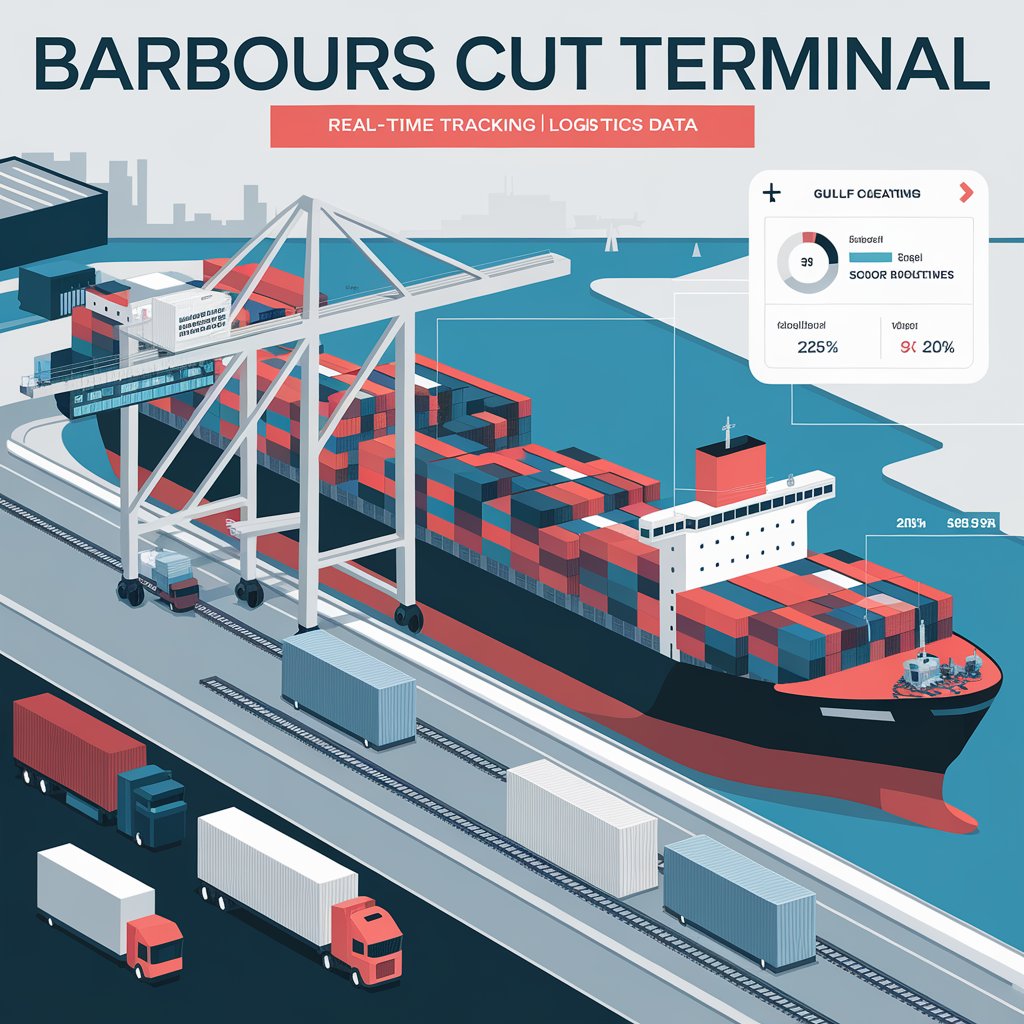Barbours Cut Terminal: A Key Player in Texas Gulf Coast Shipping

Understanding Barbours Cut Terminal
Historical Significance and Strategic Importance
Barbours Cut Terminal, operated by the Port of Houston Authority, has been a game-changer in Gulf Coast shipping since its inception in 1977. Its strategic location and advanced capabilities have made it a crucial hub for international trade.
Key Facts:
- Location: La Porte, Texas (25 miles southeast of downtown Houston)
- Opened: 1977
- Annual Container Volume: [Insert latest data] TEUs
- Terminal Area: 380 acres
- Berth Length: 6,000 feet
Barbours Cut’s Competitive Advantages
- Deep-water access for post-Panamax vessels
- State-of-the-art container handling equipment
- Excellent intermodal connections
- Proximity to major consumer markets and industrial centers
- Ongoing modernization and expansion projects
Maximizing Benefits at Barbours Cut Terminal
1. Leveraging Advanced Terminal Infrastructure
Barbours Cut Terminal boasts cutting-edge infrastructure designed to enhance efficiency:
- Super Post-Panamax Cranes: Capable of handling the largest container vessels
- Modernized Yard Equipment: Including rubber-tyred gantry cranes (RTGs) for efficient container stacking
- Automated Gates: Streamlining truck entry and exit processes
Tip for Businesses: Familiarize yourself with the terminal’s equipment capabilities to optimize your container handling strategies.
2. Utilizing Intermodal Connections
The terminal offers excellent connectivity options:
- On-dock Rail Facility: Direct access to major rail networks
- Extensive Road Network: Connections to major highways for efficient trucking
- Barge Services: Options for inland waterway transportation
Strategy: Consider integrating multiple transportation modes to reduce costs and improve supply chain flexibility.
3. Navigating Terminal Operations
Understanding the terminal’s operational procedures is crucial for smooth logistics:
- Terminal Operating System (TOS): Familiarize yourself with the terminal’s digital platforms for container tracking and appointment scheduling
- Extended Gate Hours: Take advantage of night and weekend operations to avoid peak congestion
- Customs Clearance: Leverage on-site customs facilities for faster processing
Best Practice: Establish clear communication channels with terminal operators to stay informed about operational updates and potential disruptions.
4. Capitalizing on Free Trade Zone Benefits
Barbours Cut Terminal is part of Foreign Trade Zone (FTZ) #84:
- Duty Deferral: Delay payment of duties until goods enter U.S. commerce
- Duty Elimination: Avoid duties on re-exported merchandise
- Inverted Tariff Relief: Potential for reduced duty rates on finished products
Tip: Consult with FTZ specialists to determine how your business can benefit from these incentives.
5. Adapting to Technological Advancements
Stay ahead by embracing the terminal’s technological initiatives:
- Port Community System: Utilize digital platforms for seamless information exchange
- IoT and Big Data: Leverage data analytics for better forecasting and planning
- Blockchain Initiatives: Participate in pilot programs for enhanced supply chain transparency
Strategy: Invest in compatible technologies to fully integrate with the terminal’s digital ecosystem.
Case Studies: Success Stories at Barbours Cut
Case Study 1: Automotive Parts Distributor
Challenge: Managing just-in-time inventory for a global supply chain.
Solution:
- Utilized Barbours Cut’s advanced container tracking system
- Integrated with the terminal’s appointment system for precise pickup scheduling
- Leveraged FTZ benefits for cost-effective inventory management
Results:
- 30% reduction in inventory holding costs
- 25% improvement in on-time deliveries to assembly plants
Case Study 2: Chemical Exporter
Challenge: Efficiently handling hazardous materials while meeting stringent safety regulations.
Solution:
- Collaborated with terminal operators for specialized handling procedures
- Utilized dedicated areas for hazardous cargo storage
- Implemented real-time monitoring systems for cargo condition
Results:
- 40% reduction in handling time for hazardous materials
- Zero safety incidents over a two-year period

Overcoming Challenges at Barbours Cut Terminal
1. Peak Season Congestion
Challenge: Managing increased volumes during peak shipping seasons.
Solutions:
- Utilize off-peak hours for container pickup and delivery
- Consider using nearby off-dock container yards for temporary storage
- Implement advanced forecasting to anticipate and plan for volume spikes
2. Weather-Related Disruptions
Challenge: Mitigating the impact of severe weather events common in the Gulf Coast region.
Solutions:
- Develop robust contingency plans for various weather scenarios
- Utilize the terminal’s early warning systems and communication channels
- Consider alternative routing options during hurricane season
3. Evolving Customs Regulations
Challenge: Keeping pace with changing customs procedures and regulations.
Solutions:
- Establish a dedicated team or partner with customs brokers specializing in Gulf Coast trade
- Participate in Customs-Trade Partnership Against Terrorism (C-TPAT) for expedited processing
- Regularly attend industry seminars and workshops on customs compliance
Future Developments and Opportunities
1. Terminal Expansion Project
Barbours Cut is undergoing a major modernization project:
- Berth reconstruction to accommodate larger vessels
- Implementation of semi-automated container handling systems
- Enhanced on-dock rail capabilities
Opportunity: Position your business to take advantage of increased capacity and faster turnaround times.
2. Environmental Initiatives
The terminal is focusing on sustainability:
- Electrification of cargo handling equipment
- Implementation of shore power capabilities
- Adoption of alternative fuels for terminal vehicles
Strategy: Align your sustainability goals with the terminal’s initiatives for potential partnerships and incentives.
3. Digital Transformation
Continued investment in digital technologies:
- Enhanced data analytics capabilities
- Potential implementation of AI for predictive maintenance and operations
- Exploration of 5G technology for improved connectivity
Tip: Stay informed about these developments and prepare your IT infrastructure for integration with new systems.

Key Performance Indicators (KPIs) for Barbours Cut Users
To measure your operational efficiency at Barbours Cut, focus on these key metrics:
- Container Dwell Time
- Truck Turn Time
- Vessel Turnaround Time
- Customs Clearance Time
- Intermodal Transfer Efficiency
- Cargo Damage/Loss Rate
- Documentation Accuracy
Best Practices for Businesses Using Barbours Cut Terminal
To measure your operational efficiency at Barbours Cut, focus on these key metrics:
- Container Dwell Time
- Truck Turn Time
- Vessel Turnaround Time
- Customs Clearance Time
- Intermodal Transfer Efficiency
- Cargo Damage/Loss Rate
- Documentation Accuracy

Conclusion
Barbours Cut Terminal continues to be a linchpin in Texas Gulf Coast shipping, offering unparalleled opportunities for businesses engaged in international trade. By leveraging its advanced infrastructure, strategic location, and ongoing modernization efforts, companies can significantly enhance their supply chain efficiency and competitiveness.
For businesses involved in Texas Gulf Coast trade, understanding and fully utilizing the capabilities of Barbours Cut Terminal is crucial. The strategies and insights provided in this guide serve as a roadmap for maximizing the benefits of this key logistics hub.
As global trade patterns evolve and new technologies emerge, Barbours Cut Terminal remains committed to staying at the forefront of maritime commerce. By embracing innovation, focusing on sustainability, and fostering strong partnerships with its users, Barbours Cut is well-positioned to meet the challenges of tomorrow’s shipping industry.
Businesses that align their operations with Barbours Cut’s capabilities and follow the best practices outlined here will find themselves well-equipped to thrive in the dynamic world of Gulf Coast shipping, ensuring their cargo moves swiftly and efficiently through this vital gateway of international trade.
